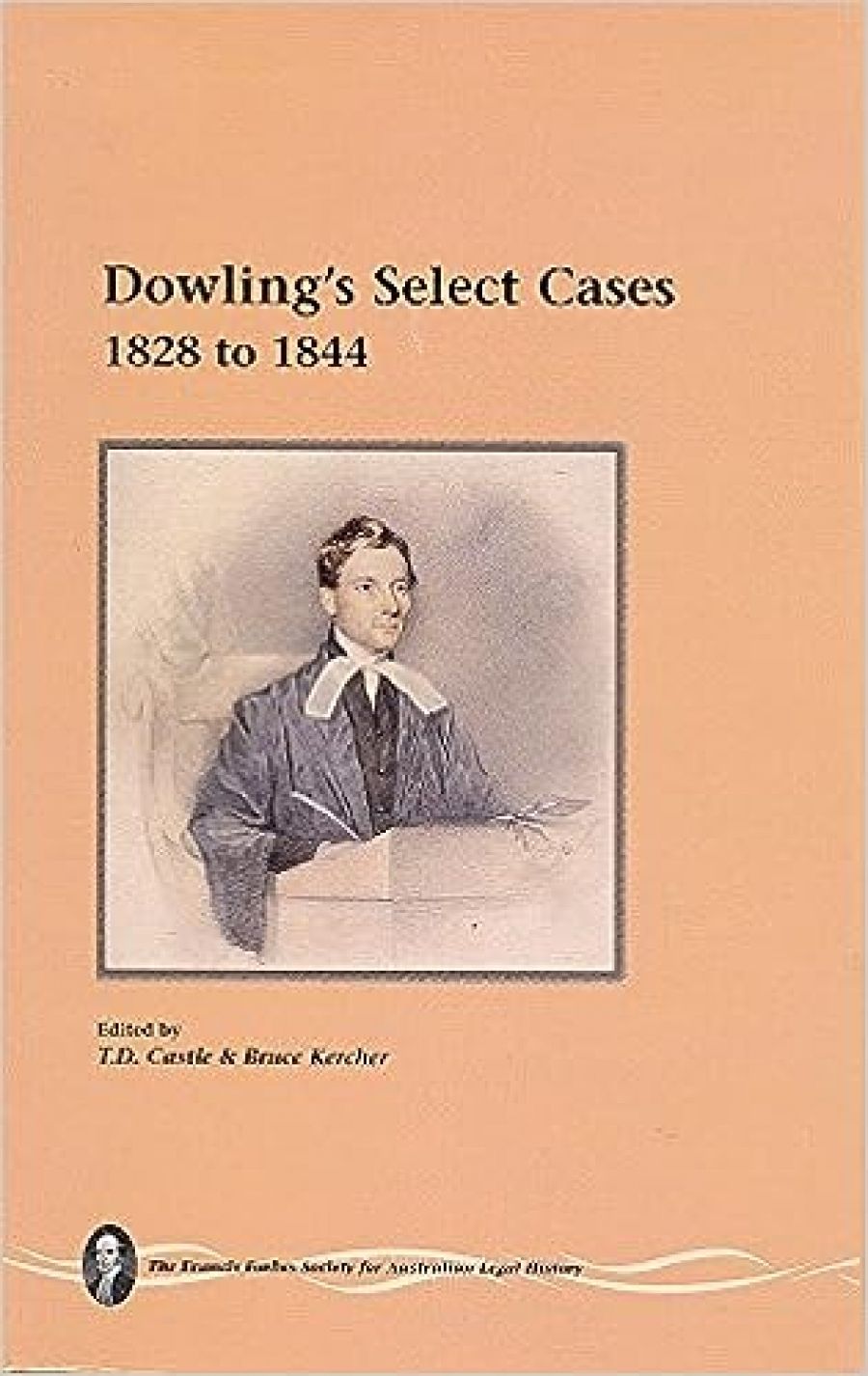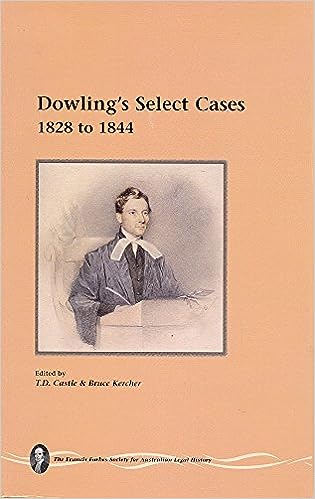
- Free Article: No
- Contents Category: Law
- Review Article: Yes
- Article Title: Legal legacies
- Online Only: No
- Custom Highlight Text:
The prodigious effort that went into the compilation of Dowling’s Select Cases was entirely consistent with his own approach to judicial office, including producing the copious writings that found their way into the book. As Dr Bennett put it in his biography of James Dowling (2001), industry and perseverance were the hallmarks of Dowling’s accomplishments. To produce the chronicle now published, the editors and their helpers followed Dowling’s notes through his nine volumes of cases, cross-referencing many to his 268 judicial notebooks. The cases were recorded by Dowling by hand and required considerable typing. They are arranged chronologically and according to subject matter. The book will not be a threat to Harry Potter but will endure as of considerable interest to lawyers and historians.
- Book 1 Title: Dowling’s Select Cases, 1828 To 1844
- Book 1 Biblio: Frances Forbes Society for Australian Legal History, $100 hb, 1035 pp
- Book 1 Cover Small (400 x 600):

James Dowling arrived in the colony on 24 February 1828 and died there on 27 September 1844. He was the fifth judge appointed to the Supreme Court of New South Wales, if we include Jeffery Bent and Barron Field, notable eccentrics who served without much lustre on the Supreme Court created in 1814 by the Second Charter of Justice. The present Supreme Court was constituted on 17 May 1824; Dowling became its second chief justice on the retirement of Forbes in 1837.
Dowling came to a community the true nature of which he probably failed to appreciate until he landed. He arrived in New South Wales with his wife and six children and little else, and for a time regretted having left England. He formed an instant, and understandable, dislike for Governor Darling. Forbes looked unwell and had a ‘round headed republican look’, while Justice Stephen seemed to be ‘marked for another world’. The colony in 1828 had a population of about 36,000, of whom about half were convicts. It was still a prison, beset by crime and riven by social unrest, as emancipated convicts sought to find a place in society alongside those who went to the colony as free people or were born of free people. There was continual tension between the judges and the governor, exacerbated by conflicts about the governor’s right to capriciously withdraw assigned convicts, and his attempt to have the Legislative Council legislate to enable the governor to license newspapers, an Act that Forbes declined to certify as being consistent with the law of England.
In all this, Dowling managed, after a while, to keep a steady course, motivated by goodwill and a desire to serve. He lacked Forbes’s erudition, and tended to express himself somewhat grandiloquently, even for the nineteenth century. For example, in 1830, during the first civil jury trial after the 1828 Act (Hall v Rossi), he was moved to expound upon the subject of trial by jury, telling the jury that ‘even as a judge (the frigid expositor of the law) I cannot abstain from hailing with gratulation the introduction of a system which places the judges of this Court upon a proper constitutional footing with their fellow subjects in the sacred Temple of Justice’.
Dowling presided during a period of monstrously harsh penal laws, yet seems to have regarded their harshness with equanimity, having no apparent qualms, for example, in 1828 in sending a man to death for stealing a cow. His deep religious conviction found expression in ways perhaps strange to us, such as by warning the cow thief that ‘Ere long you will be ushered into the awful presence of your Maker’. Almost comically, he solemnly instructed a military tribunal in 1828, during one of the many trials of Edward Smith Hall (on this occasion for the criminal libel of the Archdeacon of Sydney), that a libel against a clergyman was ‘highly injurious to society, by tending to bring scandal upon religion itself, and thereby to dissolve the sacred bonds which bind man to man: but above all, as a paramount consideration, to weaken man’s confidence in the divine attributes of his Maker’.
Dowling was himself not free from public criticism by the fledgling press. On 13 November 1839 the Sydney Herald accused him of dealing too leniently with two men accused of rape but convicted of common assault. The Herald went for his Honour’s jugular, saying ‘that murder and something worse than murder were intended there is little reason to doubt, but no, says His Honour the Chief Justice after one of his usual displays of forensic balderdash – bad logic – and threadbare casuistry, this is a mere case of common assault’.
The court did have to deal with some curious issues. For example, a case in 1831 involved the judge in granting a temporary respite of execution to two prisoners, because they had been condemned to be executed and hung in chains at the place where they had committed the murder, but the distance was too great to enable that to be accomplished before the appointed time. In 1836 John Knatchbull lost his argument that sentence of death passed on him was illegal because it omitted to express that his body should be dissected and anatomised. Their Honours were unimpressed by Knatchbull’s petition, but paid him the courtesy of delivering a lengthy judgment on the issue, concluding that the sentence was consistent with long practice ‘undeviatingly pursued for nearly seven years, without objection, even though many of the miserable culprits towards whom the course had been pursued were ably defended by counsel learned in the law’.
The conditions under which the early colonial judges worked can only be imagined by 21st-century jurists. They were in the remotest corner of empire, in a penal colony, having to deal with incompetent crown counsel, a hostile governor and a delay of perhaps twelve months in receiving an answer to a letter to London. But as the selected cases show, they gave more than their duty. In the end, the task killed Dowling as it had killed Forbes. The publication of Dowling’s cases has graphically brought to life the New South Wales community between 1822 and 1844. It is a valuable legacy.


Comments powered by CComment